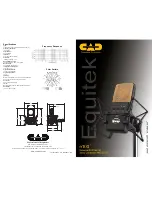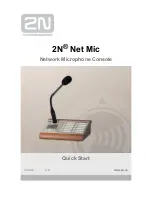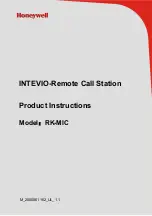
Auto Power Shut Off Configuration
The following instructions are only important if you plan on
using the e100
2
without a phantom power supply, such as for remote
DAT recording. The Equitek e100
2
incorporates a circuit which shuts
the microphone off if phantom power is removed. This is done so
that battery power will be conserved if the user forgets to turn the
microphone off. If it is desired to operate the microphone using only
the batteries, this feature must be disabled or the microphone will not
function. This is easily done by means of a small movable
configuration jumper located inside the battery cover of the
microphone. To gain access to the configuration jumper, remove the
single allen head screw near the bottom of the microphone on the
back side using the supplied 2.5mm allen wrench. Then remove the
battery cover and batteries for access to the configuration jumper. If
you do not plan to use the microphone without phantom power, it is
recommended that the configuration jumper remain in its default ON position.
ON
OFF
AUTO SHUT-OFF
AUTO SHUT-OFF
OFF
ON
A Special Note About Batteries
The high quality rechargeable batteries used in the Equitek e100
2
are Nickel Metal Hydride, or Nickle Cadmium type.
They were selected to provide long life with virtually no maintenance and have a number of properties that make them superior to
most commonly available rechargeable "9 volt" batteries:
1) Higher output voltage
2) Lower self discharge rate
3) High immunity to overcharging
If the e100
2
is operated with a 48 volt phantom power supply it is unlikely they will ever need to be recharged, even if the
microphone is unused for months. If it should ever become necessary to replace the batteries or if you simply want a spare set,
Use only high quality Nickel Metal Hydride, or Nickle Cadmium type batteries.
Mic Cable Removal
When using the included suspension mount, the microphone cable can be easily
removed by gripping the mic firmly in one hand, while pressing on the back of the
suspension mount with the thumb of your other hand, This will press the unlock button on
you mic cable which will allow the cable to be removed. Note the illustration to the left.
Optional Accessories:
EPF-15 .....
P-pop filter mounted on 15" gooseneck with standard bracket
40-350 ....... 50 ft. broadcast quality extension cable terminated with professional 3 pin
male/female connectors.
40-351 ....... 100 ft. broadcast quality extension cable.
40-352 ....... 25 ft. broadcast quality extension cable.
User Techniques and Applications
The Equitek e100
2
includes a suspension shock mount which greatly reduces handling noise. It also has an optional
swivel mount adaptor that can be used when the suspension mount isn’t practical. Both mounting adaptors allow for easy
microphone positioning and mates to any microphone stand that has standard 5/8" X 27 threads. A thread adaptor is included for
the smaller threaded mic
stands. To remove the microphone and switch to the microphone stand adaptor, loosen the large
thumb screw on the back of the mic. The e100
2
can be used in a broad number of applications,
ranging from live reinforcement to the most critical studio situations. The e100
2
is ideal for
vocals and voice overs, yet it also excels at some of the most demanding instrumental
projects. The e100
2
is great for virtually all acoustic, wind, and amplified instruments.
One of the most popular uses for the e100
2
is in miking drum sets, especially kick drums.
The e100
2
has been proven to be outstanding in all of these applications and more. Its
uncolored sonic characteristics allow you to decide how a instrument or vocal will
sound in the mix. The supercardoid polar pattern is very useful in live applications
where feedback control and tight miking are required.
ON = Microphone Power On
OFF = Microphone Power Off (Use this position switch position for fastest
charging of batteries. See below.)
Power
Pad
Hi-Pass
Left position = Low end roll off below 80 Hz.
Right Position = Flat low end response
0dB = Full gain (Highest Sensitivity)
-20dB = 20dB Gain reduction (Highest Clipping Level)
Switch Functions
The Equitek e100
2
combines
an electret condenser cap-
sule design with advanced
electronics. Typical FET
(field effect transistor) con-
denser microphones use
discrete designs. This
means they use individual
transistors that must be
carefully matched for proper
characteristics. Even with
careful matching, discrete
designs are inherently non-
linear. Equitek microphones
use a different approach.
We do not use any discrete
FETs. Instead, we use ad-
vanced high speed OpAmps
(Operational Amplifiers).
These OpAmps are individu-
ally laser trimmed for opti-
mum performance and have
very high gain. This allows
a large amount of negative
feedback to be used to sig-
nificantly reduce any non-
linearity. During transients,
these OpAmps may require
more current than typical
phantom power supplies
can deliver. The extra cur-
rent demands are accommo-
dated by our unique power
supply design. Instead of
using phantom power to op-
erate the microphone, we
use it to charge a pair of re-
chargeable batteries. This
system creates a huge cur-
rent reserve for the
microphone's electronics,
yet there is no maintenance
involved because the micro-
phone automatically keeps
the batteries charged during
use. The use of OpAmps is
not the only unique feature
of Equitek microphones.
For example, we also em-
ploy servo circuitry to mini-
mize DC offset and eliminate
interstage coupling capaci-
tors. The bottom line is we
believe you will find the
Equitek e100
2
to have a re-
markably open and clean
sound that will enhance any
project.
Professional Microphones
e100
2
Description
The Equitek e100
2
from CAD is a single pattern supercardioid side address
microphone designed for recording, broadcast and live applications. The implementation
of high speed, low noise, low distortion electronics makes the Equitek e100
2
the ideal
candidate for the most critical applications.
The Equitek e100
2
incorporates a number of unique features including:
• Servo head amplifiers.
• High SPL Capability (148 dB SPL with pad).
• Transformerless balanced output circuits.
• Internal Power reservoir system that can supply ten times the current
available from phantom powering alone.
• Triple point internal shock isolation system..
• Remote operation without phantom power using internal batteries.
• 20 dB non capacitive pad.
• Stainless steel internal pop/EMI filter.
• Automatic power shut down circuit.
Getting Started
The e100
2
requires 48 volt phantom power and the internal batteries must be
charged for proper operation. Although the internal batteries were charged at the factory,
the batteries will gradually self-discharge if the microphone has been in storage for a long
time. It may be necessary to charge the batteries before initial use. Please see the section
below on powering the Equitek e100
2
.
Caution!
The high gain and wide bandwidth of the e100
2
microphone will easily overload
the inputs of many professional mixing consoles if adequate precautions are not taken.
This is especially true if the mic is going to be used on percussion or amplified electronic
instruments. If you have never used this microphone before, we strongly recommend that
you initially reduce the system gain by doing one or more of the following:
• Enable the pad switch on the input of your mixing console.
• Start with the input trim control on your mixing console turned down to a low
level.
• Enable the -20 dB pad switch on the e100
2
microphone.
Powering the Equitek E-100
2
The Equitek e100
2
is powered by a combination of 48 volt phantom power and a
pair of rechargeable 9 volt batteries. This powering arrangement overcomes the inherent
current limiting associated with most phantom power supplies. The batteries are trickle
charged by the phantom supply. When needed, the batteries provide the extra current
necessary during high SPL transients. The microphone will not function properly without
the batteries present. The microphone can be used without phantom power for periods of
up to 6 hours provided the batteries are fully charged. Standard 9 volt alkaline batteries
can also be used if extended operation is needed when no phantom power is available.*
(Auto power shut off circuit must be disabled for battery operation without phantom
power.) The minimum requirement for the phantom supply is a regulated 48 volts with the
capability of supplying at least 8 mA. of current. Supplies that do not meet this
requirement will not allow continuous operation of the microphone. Before initial use, the
batteries may need to be fully charged. Once the batteries have received this initial
charge, they should not need to be charged in this manner again, unless the microphone is
unused for a long time. The batteries can be charged by two different means:
• Connect the microphone to a phantom supply and allow the batteries to charge 12 -
14 hours with the mic turned off.
• Remove the batteries from the microphone and charge using a standard battery
charger.
* See the section on Auto Power Shut Off.
IF USING ALKALINE 9 VOLT BATTERIES, DO NOT APPLY PHANTOM
POWER TO THE MICROPHONE! DOING SO COULD CAUSE PERMANENT
DAMAGE TO THE MICROPHONE AND VOID YOUR WARRANTY!
NOTE: If you normally operate the microphone from phantom power, it is best to
leave the microphone power switch in the "on" position at all times. (The microphone
automatically shuts off to conserve battery power when phantom power is removed.)




















